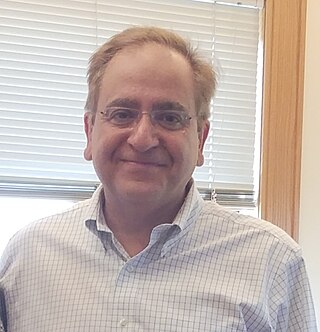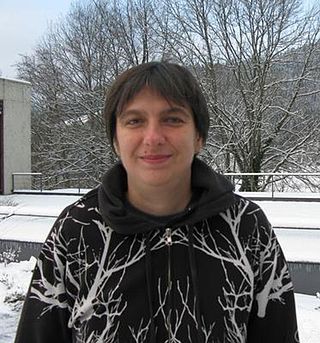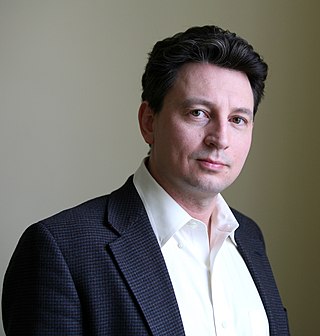
Edward Witten is an American theoretical physicist known for his contributions to string theory, topological quantum field theory, and various areas of mathematics. He is a professor emeritus in the school of natural sciences at the Institute for Advanced Study in Princeton. Witten is a researcher in string theory, quantum gravity, supersymmetric quantum field theories, and other areas of mathematical physics. Witten's work has also significantly impacted pure mathematics. In 1990, he became the first physicist to be awarded a Fields Medal by the International Mathematical Union, for his mathematical insights in physics, such as his 1981 proof of the positive energy theorem in general relativity, and his interpretation of the Jones invariants of knots as Feynman integrals. He is considered the practical founder of M-theory.

Cumrun Vafa is an Iranian-American theoretical physicist and the Hollis Professor of Mathematics and Natural Philosophy at Harvard University.

Nima Arkani-Hamed is an American-Canadian theoretical physicist of Iranian descent, with interests in high-energy physics, quantum field theory, string theory, cosmology and collider physics. Arkani-Hamed is a member of the permanent faculty at the Institute for Advanced Study in Princeton, New Jersey. He is also director of the Carl P. Feinberg Cross-Disciplinary Program in Innovation at the Institute and director of The Center for Future High Energy Physics (CFHEP) in Beijing, China.
Shamit Kachru is an American theoretical physicist, a professor emeritus of physics at Stanford University, and a former Wells Family Director of the Stanford Institute for Theoretical Physics. He served as the Stanford Physics Department Chair from 2018 to 2021. He retired in 2023.
Eva Silverstein is an American theoretical physicist, cosmologist, and string theorist. She is a professor of physics at Stanford University and director of the Modern Inflationary Cosmology collaboration within the Simons Foundation Origins of the Universe initiative.
Quantum weirdness encompasses the aspects of quantum mechanics that challenge and defy human physical intuition.
The term "bootstrap model" is used for a class of theories that use very general consistency criteria to determine the form of a quantum theory from some assumptions on the spectrum of particles. It is a form of S-matrix theory.
Stephen Parke is a New Zealand physicist. He is a distinguished scientist and former head of the Theoretical Physics Department at the Fermi National Accelerator Laboratory.
In non-technical terms, M-theory presents an idea about the basic substance of the universe. Although a complete mathematical formulation of M-theory is not known, the general approach is the leading contender for a universal "Theory of Everything" that unifies gravity with other forces such as electromagnetism. M-theory aims to unify quantum mechanics with general relativity's gravitational force in a mathematically consistent way. In comparison, other theories such as loop quantum gravity are considered by physicists and researchers to be less elegant, because they posit gravity to be completely different from forces such as the electromagnetic force.

Matilde Marcolli is an Italian and American mathematical physicist. She has conducted research work in areas of mathematics and theoretical physics; obtained the Heinz Maier-Leibnitz-Preis of the Deutsche Forschungsgemeinschaft, and the Sofia Kovalevskaya Award of the Alexander von Humboldt Foundation. Marcolli has authored and edited numerous books in the field. She is currently the Robert F. Christy Professor of Mathematics and Computing and Mathematical Sciences at the California Institute of Technology.
Raphael Bousso is a theoretical physicist and cosmologist. He is a professor at the Berkeley Center for Theoretical Physics in the Department of Physics, UC Berkeley. He is known for the Bousso bound on the information content of the universe. With Joseph Polchinski, Bousso proposed the string theory landscape as a solution to the cosmological constant problem.

In mathematics and theoretical physics, an amplituhedron is a geometric structure introduced in 2013 by Nima Arkani-Hamed and Jaroslav Trnka. It enables simplified calculation of particle interactions in some quantum field theories. In planar N = 4 supersymmetric Yang–Mills theory, also equivalent to the perturbative topological B model string theory in twistor space, an amplituhedron is defined as a mathematical space known as the positive Grassmannian.
Pankaj Mehta is an American theoretical physicist whose research has involved biophysics, statistical physics, machine learning theory, and hard condensed matter theory. He is a professor of Physics at Boston University.
Nautilus Magazine is a New York–based online and print science magazine. It publishes one issue on a selected topic each month on its website, releasing one chapter each Thursday. Issue topics have included human uniqueness, time, uncertainty, genius, mergers & acquisitions, and feedback. Nautilus also publishes a print edition six times a year, and a daily blog entitled, Facts So Romantic.
Freddy Alexander Cachazo is a Venezuelan-born theoretical physicist who holds the Gluskin Sheff Freeman Dyson Chair in Theoretical Physics at the Perimeter Institute for Theoretical Physics in Waterloo, Ontario, Canada.
Quanta Magazine is an editorially independent online publication of the Simons Foundation covering developments in physics, mathematics, biology and computer science.
Suchitra Sebastian is a condensed matter physicist at Cavendish Laboratory, University of Cambridge. She is known for her discoveries of exotic quantum phenomena that emerge in complex materials. In particular, she is known for the discovery of unconventional insulating materials which display simultaneous conduction-like behaviour. In 2022 she was awarded the New Horizons in Physics Prize by the Breakthrough Foundation. She was named as one of thirty Exceptional Young Scientists by the World Economic Forum in 2013, one of The Next Big Names in Physics by the Financial Times in 2013, and spoke at the World Economic Forum at Davos in 2016.

Victor Galitski is a Russian-American physicist, a theorist working in the area of quantum physics.
Gravitational decoherence is a term for hypothetical mechanisms by which gravitation can act on quantum mechanical systems to produce decoherence. Advocates of gravitational decoherence include Frigyes Károlyházy, Roger Penrose and Lajos Diósi.
The SLAC Theory Group is the hub of theoretical particle physics research at the SLAC National Accelerator Laboratory at Stanford University. It is a subdivision of the Elementary Particle Physics (EPP) Division at SLAC.





